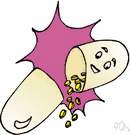granule
(redirected from Birbeck granules)Also found in: Thesaurus, Medical, Encyclopedia, Wikipedia.
gran·ule
(grăn′yo͞ol)n.
1. A small grain or pellet; a particle.
2. Geology A rock or mineral fragment larger than a sand grain and smaller than a pebble, between 2 and 4 millimeters in diameter.
3. Astronomy One of the small, transient, luminous markings in the photosphere of the sun.
4. Biology A cellular or cytoplasmic particle, especially one that stains readily.
American Heritage® Dictionary of the English Language, Fifth Edition. Copyright © 2016 by Houghton Mifflin Harcourt Publishing Company. Published by Houghton Mifflin Harcourt Publishing Company. All rights reserved.
granule
(ˈɡrænjuːl)n
1. a small grain
2. (Geological Science) geology a single rock fragment in gravel, smaller than a pebble but larger than a sand grain
3. (Astronomy) astronomy another name for granulation5
[C17: from Late Latin grānulum a small grain]
Collins English Dictionary – Complete and Unabridged, 12th Edition 2014 © HarperCollins Publishers 1991, 1994, 1998, 2000, 2003, 2006, 2007, 2009, 2011, 2014
gran•ule
(ˈgræn yul)n.
1. a little grain.
2. a small particle; pellet.
Random House Kernerman Webster's College Dictionary, © 2010 K Dictionaries Ltd. Copyright 2005, 1997, 1991 by Random House, Inc. All rights reserved.
ThesaurusAntonymsRelated WordsSynonymsLegend:
Switch to new thesaurus
| Noun | 1. |  granule - a tiny grain granule - a tiny grain microsome - a tiny granule in the cytoplasm that is where protein synthesis takes place under the direction of mRNA chondrule - small granule (of e.g. chrysolite) found in some meteoric rocks grain - a relatively small granular particle of a substance; "a grain of sand"; "a grain of sugar" plastid - any of various small particles in the cytoplasm of the cells of plants and some animals containing pigments or starch or oil or protein |
Based on WordNet 3.0, Farlex clipart collection. © 2003-2012 Princeton University, Farlex Inc.
granule
noun grain, scrap, molecule, particle, fragment, atom, crumb, jot, speck, iota granules of coarse-grain sea salt
Collins Thesaurus of the English Language – Complete and Unabridged 2nd Edition. 2002 © HarperCollins Publishers 1995, 2002
Translations
حُبيْبَه
zrnko
lille korn
smákorn, ögn
granuliuotasgrūdėtas
granulagraudiņš
Collins Spanish Dictionary - Complete and Unabridged 8th Edition 2005 © William Collins Sons & Co. Ltd. 1971, 1988 © HarperCollins Publishers 1992, 1993, 1996, 1997, 2000, 2003, 2005
Collins English/French Electronic Resource. © HarperCollins Publishers 2005
granule
n → Körnchen nt
Collins German Dictionary – Complete and Unabridged 7th Edition 2005. © William Collins Sons & Co. Ltd. 1980 © HarperCollins Publishers 1991, 1997, 1999, 2004, 2005, 2007
Collins Italian Dictionary 1st Edition © HarperCollins Publishers 1995
granule
(ˈgrӕnjuːl) noun a very small particle. a granule of sugar.
ˈgranular adjectiveˈgranulated (-lei-) adjective
broken into tiny particles. granulated sugar.
Kernerman English Multilingual Dictionary © 2006-2013 K Dictionaries Ltd.
gran·ule
n. gránulo, partícula pequeña formada de gránulos;
acidophil ___ → ___ acidófilo, que acepta colorantes ácidos;
basophil ___ → ___ basófilo, que acepta colorantes básicos.
English-Spanish Medical Dictionary © Farlex 2012
granule
n gránuloEnglish-Spanish/Spanish-English Medical Dictionary Copyright © 2006 by The McGraw-Hill Companies, Inc. All rights reserved.